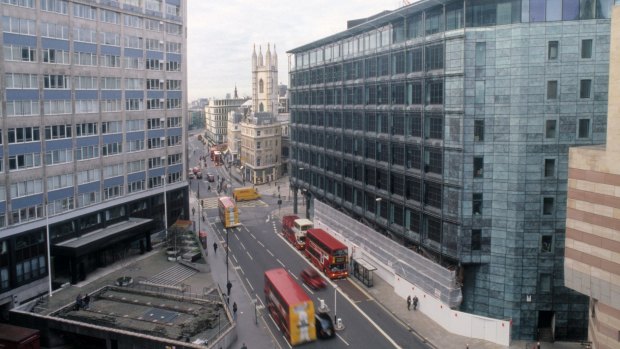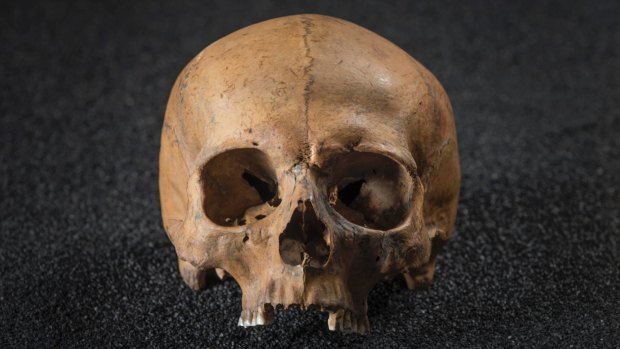This was published 5 years ago
Roman historical sites in London: Two of the best places to visit
By Keith Austin

Deep beneath the swanky European HQ of the Bloomberg company in central London is the Roman Temple of Mithras.
Ask any Londoner what the massive Crossrail engineering project has done for them and they'll cite disruption, confusion and chaos – rarely will they mention dead Romans.
Since construction of the ambitious cross-London Elizabeth rail line began in 2009, archaeologists have unearthed tens of thousands of objects, from medieval plague pits to rare coins to decapitated skulls.
Some of the best finds have been from the period after the Romans established a settlement – Londinium – on the banks of what we now call the Thames. They arrived in AD43 and left 350 years later, leaving behind state-of-the-art amphitheatres, forums and temples which were then mostly torn down by the locals for the stone.

In Finsbury Circus we learn that they found 50 skulls at the Crossrail ventilation shaft site. "Not bodies, just the skulls."Credit: Museum of London
For those interested in Roman London there are now several ways to dig up more information on the birth of one of the greatest capitals of the world. Here are two of the best.
LONDINIUM MORTUUM
Organised by the London Museum Docklands, the northern cemetery walk is one of a series of tours exploring some of London's key Roman burial sites. We meet Blue Badge guide Julie Chandler outside Moorgate Underground station, under the noise of one of the Crossrail digs.
"During the time the Romans were here," she says by way of introduction, "somewhere in the region of 250,000 to 300,000 people lived and died here. However, over the centuries … we've only found a tiny fragment of those people. Less than 1 per cent, really quite a very tiny number.
"And where we've found them, of course, is down below our feet. Because Roman Londinium is about 15-20 feet (4.5-6 metres) below ground."
In the course of the next two hours Chandler walks and talks us through the bustling streets and alleyways of the City of London. We learn that the laws of the time stated you could neither "burn nor bury" your dead inside the city walls and that the constant building and rebuilding of London ("it will never be finished") keeps throwing up new finds as fresh foundations are excavated .
In Finsbury Circus we learn that they found 50 skulls at the Crossrail ventilation shaft site. "Not bodies, just the skulls," says Chandler.
One of the most poignant places we visit is at the base of 30 St Mary Axe – better known locally as The Gherkin. When it was being built in 1995 workers found the skeleton of a girl aged somewhere between 13 and 17 who had lain there undisturbed for 1600 years.
In 2007 she was reburied, with requisite pomp and circumstance, close to where she had been found. Today the site is marked with a simple laurel leaf paving stone and an inscription in Latin and English on the wall nearby. It reads simply: "To the spirits of the dead, the unknown young girl, from Roman London, lies buried here."
A Londoner for ever more.
You need a reasonable level of fitness for these walks which cost £20 (A$35) per adult. Minimum age is 12. See museumoflondon.org.uk and follow the links to London Museum Docklands. .
LONDON MITHRAEUM
Deep beneath the swanky European HQ of the Bloomberg company in central London is the Roman Temple of Mithras. First discovered on what was then a bomb site in 1954, the temple captured the imagination of post-war Britain, with thousands of people queuing up to see it every day.
After a chequered and controversial history which saw it dismantled and moved to a new spot in Temple Court, it has now finally moved back to its original location (more or less).
Inside, on the ground floor, a huge glass case holds some of the artefacts – pots, spoons, brooches, unguentaria (perfume bottles), among other things - that were found on the site. In a nice modern twist the attendants lend you a touch-screen tablet with which you can identify the pieces.
Seven metres below that, the reconstructed ruins of the temple to the god Mithras sit in a darkened room. Every 20 minutes or so there is a low key "show" which uses sound and light and shadows and mist to recreate the temple as it might have been almost 2,000 years ago.
It's both wonderful and free.
The London Mithraeum is at 12 Walbrook, London, EC4N. Entry is free but due to popular demand it's best to book to guarantee a place. See londonmithraeum.com
Keith Austin was a guest of VisitBritain, see visitbritain.com/au
Sign up for the Traveller Deals newsletter
Get exclusive travel deals delivered straight to your inbox. Sign up now.